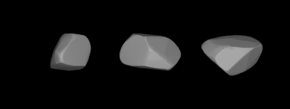1805 Dirikis
 Lightcurve-based 3-D model of Dirikis | |
| Discovery[1] | |
|---|---|
| Discovered by | L. Chernykh |
| Discovery site | Crimean Astrophysical Obs. |
| Discovery date | 1 April 1970 |
| Designations | |
| (1805) Dirikis | |
Named after | Matiss Dirikis (astronomer)[2] |
| 1970 GD · 1942 EJ 1948 JH · 1948 JM 1950 TU1 · 1953 EL 1955 QL1 · 1959 JP 1962 WP · 1962 XC1 1964 FE | |
| main-belt · Themis[3] | |
| Orbital characteristics[1] | |
| Epoch 4 September 2017 (JD 2458000.5) | |
| Uncertainty parameter 0 | |
| Observation arc | 66.20 yr (24,178 days) |
| Aphelion | 3.4915 AU |
| Perihelion | 2.7911 AU |
| 3.1413 AU | |
| Eccentricity | 0.1115 |
| 5.57 yr (2,034 days) | |
| 235.42° | |
| Inclination | 2.5157° |
| 78.926° | |
| 86.389° | |
| Physical characteristics | |
| Dimensions | 22.05±1.37 km[4] 25.53 km (derived)[3] 25.70±2.7 km[5] 27.228±0.251 km[6] 28.098±0.238 km[7] |
| 23.0±0.3 h[8] 23.4543 h[9] | |
| 0.0746 (derived)[3] 0.0893±0.0076[7] 0.095±0.007[6] 0.1065±0.026[5] 0.145±0.019[4] | |
| S[3] | |
| 11.0[4][5][7] · 11.4[1][3] | |
1805 Dirikis, provisional designation 1970 GD, is a stony Themistian asteroid from the outer region of the asteroid belt, approximately 26 kilometers in diameter.
It was discovered on 1 April 1970, by Russian astronomer Lyudmila Chernykh at the Crimean Astrophysical Observatory in Nauchnyj on the Crimean peninsula.[10] It was named for Latvian astronomer Matiss Dirikis.[2]
Orbit and classification[edit]
The S-type asteroid is a member of the Themis family,[3] a dynamical population of outer-belt asteroids with nearly coplanar ecliptical orbits. It orbits the Sun at a distance of 2.8–3.5 AU once every 5 years and 7 months (2,034 days). Its orbit has an eccentricity of 0.11 and an inclination of 3° with respect to the ecliptic.[1]
It was first observed at the Finnish Turku Observatory during WWII in 1942. The body's first used observation was its identification as 1955 QL1 at Goethe Link Observatory in 1955, extending the asteroid's observation arc by 15 years prior to its official discovery observation.[10]
Physical characteristics[edit]
Rotation period[edit]
A rotational lightcurve of Dirikis was obtained from photometric observations taken by French amateur astronomer René Roy In April 2003. It gave a rotation period of 23.0 hours with a brightness variation of 0.45 magnitude (U=2).[8] A 2013-published period of 23.45 hours was derived in an international study (U=n.a.).[9]
Diameter and albedo[edit]
According to the surveys carried out by the Infrared Astronomical Satellite IRAS, the Japanese Akari satellite, and NASA's Wide-field Infrared Survey Explorer with its subsequent NEOWISE mission, Dirikis measures between 22.05 and 28.10 kilometers in diameter, and its surface has an albedo between 0.089 and 0.145.[4][5][6][7] The Collaborative Asteroid Lightcurve Link derives an albedo of 0.075 and calculates a diameter of 25.53 kilometers with an absolute magnitude of 11.4.[3]
Naming[edit]
This minor planet was named for astronomer Matiss A. Dirikis (1923–1993), who was a member of the Astronomical Observatory at the University of Latvia, and chairman of the Latvian branch of the Astronomical–Geodetical Society of the U.S.S.R.. His work on the motion of small Solar System bodies also contributed to the field of theoretical astronomy.[2] The official naming citation was published by the Minor Planet Center on 1 January 1974 (M.P.C. 3569).[11]
References[edit]
- ^ a b c d "JPL Small-Body Database Browser: 1805 Dirikis (1970 GD)" (2016-12-25 last obs.). Jet Propulsion Laboratory. Retrieved 3 June 2017.
- ^ a b c Schmadel, Lutz D. (2007). "(1805) Dirikis". Dictionary of Minor Planet Names – (1805) Dirikis. Springer Berlin Heidelberg. p. 145. doi:10.1007/978-3-540-29925-7_1806. ISBN 978-3-540-00238-3.
- ^ a b c d e f g "LCDB Data for (1805) Dirikis". Asteroid Lightcurve Database (LCDB). Retrieved 16 December 2016.
- ^ a b c d Usui, Fumihiko; Kuroda, Daisuke; Müller, Thomas G.; Hasegawa, Sunao; Ishiguro, Masateru; Ootsubo, Takafumi; et al. (October 2011). "Asteroid Catalog Using Akari: AKARI/IRC Mid-Infrared Asteroid Survey". Publications of the Astronomical Society of Japan. 63 (5): 1117–1138. Bibcode:2011PASJ...63.1117U. doi:10.1093/pasj/63.5.1117. (online, AcuA catalog p. 153)
- ^ a b c d Tedesco, E. F.; Noah, P. V.; Noah, M.; Price, S. D. (October 2004). "IRAS Minor Planet Survey V6.0". NASA Planetary Data System. 12: IRAS-A-FPA-3-RDR-IMPS-V6.0. Bibcode:2004PDSS...12.....T. Retrieved 22 October 2019.
- ^ a b c Masiero, Joseph R.; Mainzer, A. K.; Grav, T.; Bauer, J. M.; Cutri, R. M.; Dailey, J.; et al. (November 2011). "Main Belt Asteroids with WISE/NEOWISE. I. Preliminary Albedos and Diameters". The Astrophysical Journal. 741 (2): 20. arXiv:1109.4096. Bibcode:2011ApJ...741...68M. doi:10.1088/0004-637X/741/2/68. Retrieved 16 December 2016.
- ^ a b c d Mainzer, A.; Grav, T.; Masiero, J.; Hand, E.; Bauer, J.; Tholen, D.; et al. (November 2011). "NEOWISE Studies of Spectrophotometrically Classified Asteroids: Preliminary Results". The Astrophysical Journal. 741 (2): 25. arXiv:1109.6407. Bibcode:2011ApJ...741...90M. doi:10.1088/0004-637X/741/2/90.
- ^ a b Behrend, Raoul. "Asteroids and comets rotation curves – (1805) Dirikis". Geneva Observatory. Retrieved 16 December 2016.
- ^ a b Hanus, J.; Broz, M.; Durech, J.; Warner, B. D.; Brinsfield, J.; Durkee, R.; et al. (November 2013). "An anisotropic distribution of spin vectors in asteroid families". Astronomy and Astrophysics. 559: 19. arXiv:1309.4296. Bibcode:2013A&A...559A.134H. doi:10.1051/0004-6361/201321993.
- ^ a b "1805 Dirikis (1970 GD)". Minor Planet Center. Retrieved 16 December 2016.
- ^ Schmadel, Lutz D. (2009). "Appendix – Publication Dates of the MPCs". Dictionary of Minor Planet Names – Addendum to Fifth Edition (2006–2008). Springer Berlin Heidelberg. p. 221. doi:10.1007/978-3-642-01965-4. ISBN 978-3-642-01964-7.
External links[edit]
- Asteroid Lightcurve Database (LCDB), query form (info Archived 16 December 2017 at the Wayback Machine)
- Dictionary of Minor Planet Names, Google books
- Asteroids and comets rotation curves, CdR – Observatoire de Genève, Raoul Behrend
- Discovery Circumstances: Numbered Minor Planets (1)-(5000) – Minor Planet Center
- 1805 Dirikis at AstDyS-2, Asteroids—Dynamic Site
- 1805 Dirikis at the JPL Small-Body Database
